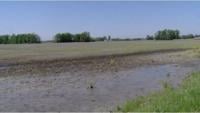WSIL � Farmers locally and nationwide are becoming more and more pressed for time when it comes to planting corn and soy beans.
Marc Lamcyzk, Program Coordinator with the University of Illinois Extension in Franklin County says, "You just drive through the country and there’s not a lot of field work done, weeds, are growing like crazy, it’s going to get interesting before it gets better."
Aaron Henry, Crop Specialist with Southern FS explains "Last year, at this time corn was already planted here and probably would’ve been coming up."
Rain, rain, and more rain has prevented farmers from being about to get out into the fields. Our numbers from the station show that we have received over 22 inches of rain this year, nearly 4 inches above normal.
Leon McClerren, a farmer from Thompsonville says, "We’ve been extremely wet, it’s probably one of the wettest periods that we’ve ever experienced in southern Illinois in my lifetime."
McClerren also says that corn by this time of year is typically a foot above the ground.
Lamcyzk elaborates, "The few fields that are planted, it’s pretty yellow and the low spots are drowned out, so there’s going to be a lot of spotting in or even some replanting."
This is not just happening locally but statewide and nationwide. Henry says that the state of Illinois has approximately 11 percent of corn planted compared to 82 percent this same time last year.
Henry says, "I would say here immediately in Williamson [County], we’re well below those percentages on planted acres, southern Illinois as a whole would maybe fall close to those."
Henry says he is concerned about this year’s crops even after farmers get in the fields, "It’s more risky, too. Just depending on the weather were given for the rest of the growing season, later planted crop is more susceptible to diseases, harvest will be later, corn will come out of the fields wetter."
Local experts say despite the challenges, consumers should see little to no impact when it comes to corn prices this year.














